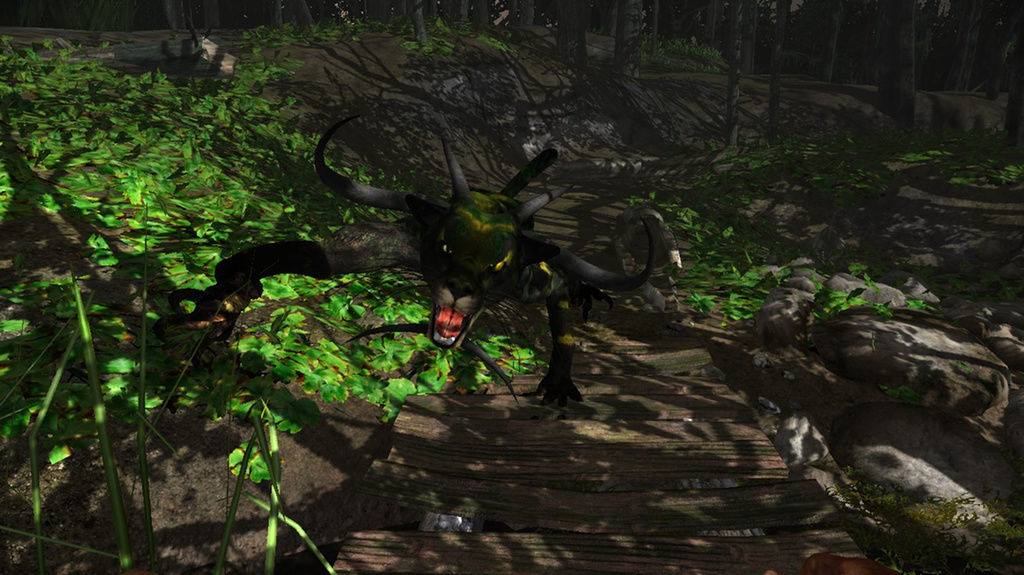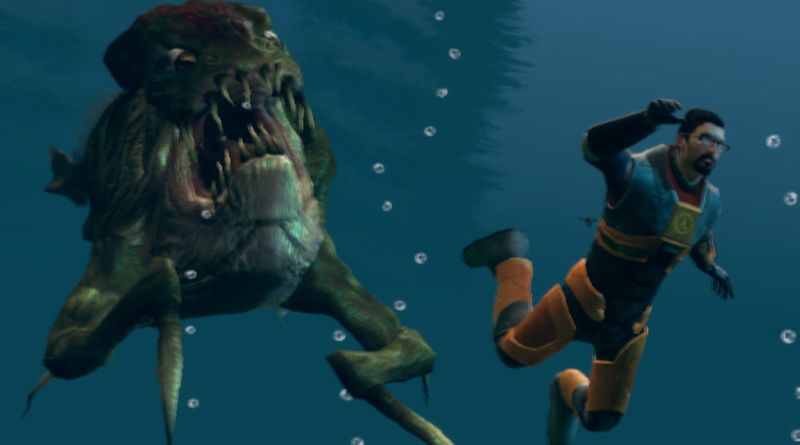How to Design Enemies That Are Truly Scary
There are many, many enemies in video games designed to be scary, and I wanted to take some time to talk about ways to make enemies that fulfill this trope without resorting to “cheap” tactics like jumpscares or making them speedy OHKOs. Note that this article is mostly interested in “normal” enemies, not single boss-like monsters (like Spider from LIMBO) or full-fledged NPCs (like Pyramid Head from Silent Hill). Also I’m not an art major so my focus is on game mechanics and AI behaviors, and less on appearances.
One of the scariest monsters I’ve had to fight in any game was the Icthyosaur from Half-Life. There is nothing right about retrieving a crossbow from a shark cage, only for said cage to break and plummet 50 feet down into a flooded room, forcing you to duel a brand new monster while trying to find an exit ladder before you drown. There’s a reason Half-Life 2 used it exactly once, for a jumpscare that was arguably scarier due to its uniqueness.
The Icthyosaur’s effectiveness comes from forcing the player to submerge themselves in water before they can fight it, which immediately puts the player at a severe disadvantage due to the 3-dimensional combat, murky visibility and most of your guns no longer working. Another game with a similar trick is Amnesia: The Dark Descent, which puts their aquatic monster on the offensive. The Kaernk can only attack Daniel when he’s in the water, forcing the player to leapfrog across furniture and debris or risk being assaulted. As Amensia only contains ankle-high water, the Kaernk is also completely invisible, forcing the player to disturb the water just to learn the creature’s location from its footsplashes. Both of these monsters work due to the linear natures of the game; the player has no choice but to progress through the water-logged sections, so these enemies can wait patiently and assault the player at the best opportunity.
When designing enemies who aren’t restricted to a single terrain, there are still options for making certain enemies particularly memorable. Speedy enemies are scary for the same reason as jumpscares; they cause the player to panic. Most of the effective enemies in this category are large and powerful; most players of Left 4 Dead can remember their first time seeing a Tank. They Hunger, a Half-Life mod, has one of my favorite encounters of this nature. The player has just navigated a stretch of forest, when they hear this otherworldly call, followed by footsteps approaching from where they’d just come. They turn around to see a charging zombie cow who dwarfs all the human zombies we’ve fought up till now.
(Note: This video only showcases the monster, that’s not the moment you first spot a cow. I couldn’t find footage of the first sighting on Youtube and I don’t remember the game well enough to find it myself.) This monster is effective both because it plays very differently to the other zombies in the game (They Hunger zombies are the slow, shambling kind) and because its character model is starkly different to anything we’d seen before. The other reason I like this particular fight is that it forces you to “retreat” into unfamiliar territory, which makes the player vulnerable as he’s trying to keep an eye on his surroundings and the cow at the same time.
Speaking of size, sometimes it works even better to make the speedy ambush monster tiny. These monsters are usually very low on health but difficult to hit, and its a delicate balance to avoid them from becoming simply frustrating instead of scary, as nobody likes dying to something because they couldn’t hit it. The most triumphant example of this article appears this category; I’d personally vote the Poison Headcrab from Half Life 2 the scariest monster in any video game I’ve ever played due to its unique damage-dealing style. A single hit from a Poison headcrab drops your HP to 1, whereupon you’ll regenerate your health very rapidly but be at extreme risk of dying to the other traditional enemies who are no doubt attacking at the same time as the Poison Headcrabs. I have never wasted so much ammunition as the time the floor broke and dropped Gordon into a dark cellar with almost a dozen Poison Headcrabs. It was only after a frenzied panic where I’d painted every square inch of the walls with bullets and their corpses littered my feet that I realized they were actually incapable of killing me since they were alone.

For developers willing to put in the legwork for convincingly dynamic AI, any monster that seems to stalk the player can easily trigger the primitive part of our brain that remembers how preylike an unarmed human really is. One of the scariest things about the catlike…thing that stalks the player in Miasmata is how intelligent it seemed; at any moment you couldn’t be sure it wasn’t prowling the bushes around you, as it would happily wait for you to take out your journal or march into unmapped territory before circling in closer, and in many cases the first danger sign the player receives is the island rabbits and songbirds fleeing from the area. The ReDead from the Zelda franchise combine the terror of immobility with that feeling of being stalked; the worst part isn’t triggering their scream, it’s being unable to move as it lurches slowly towards you to nibble your hearts away.
To wrap this article up, I should note that part of the reason the monsters on this list are so effective are the relative normalcy of the other monsters teaming up with them. The ordinary mooks — be them zombies or aliens or robots — set the standard for the gameplay, and then these monsters scare us by taking those rules and breaking them in the worst possible ways. That’s why some of the scariest monsters ever come from unintended glitches, which are fully prepared to break our perceptions of the game’s reality harder than any developer would dare. Case in point:
This article is part of my “On Shooters” series, where I compare multiple games by focusing on a specific game mechanic or developer objective. To read the rest, click here!
